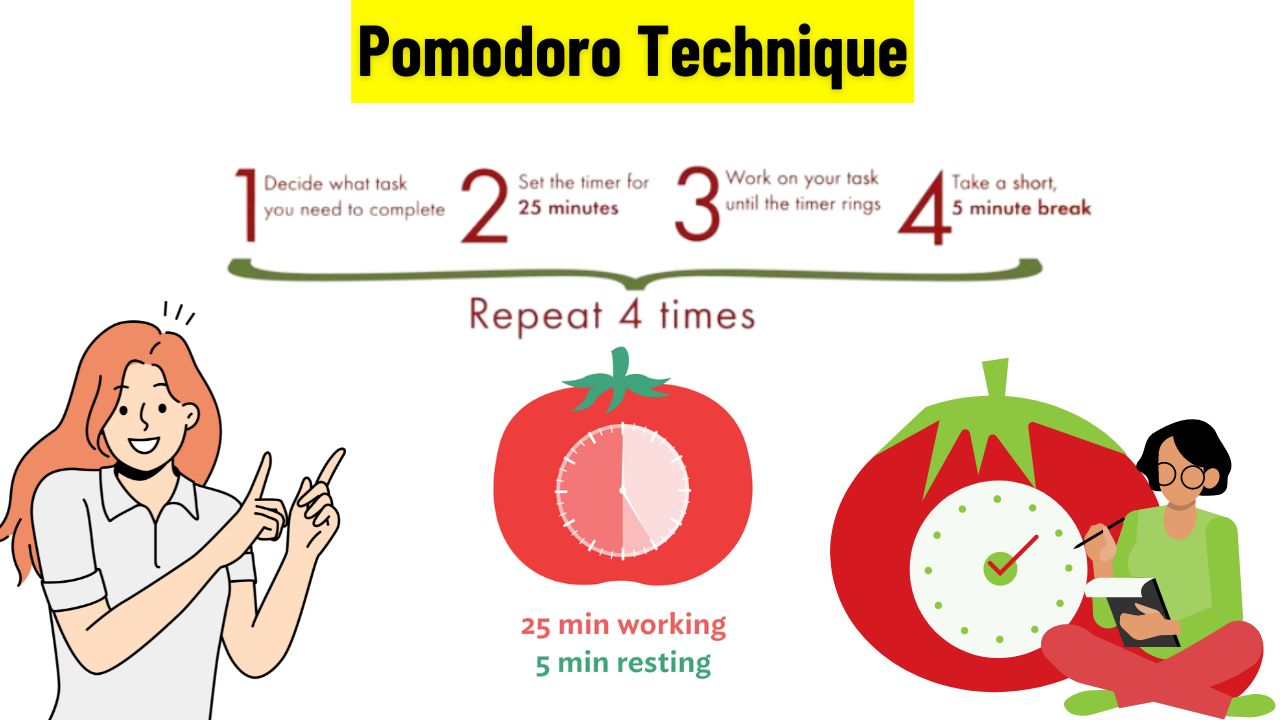Do you find yourself drowning in distractions and unable to focus on the task at hand? If maintaining focus and productivity feels like a battle for you then you are at the right place because I have a practical solution for you i.e. Pomodoro Technique.
Pomodoro Technique is a powerful time management method that has revolutionized the way millions of people work and helped them to supercharge their productivity and reclaim control over their time.
In this article, I will dive deep into the heart of the Pomodoro technique, exploring what it is, how it works, and most importantly how you can use it to transform your productivity levels and accomplish more in less time.
So, are you ready to say goodbye to procrastination and hello to productivity? Then let’s get started and work together to defeat your enemy distractions using this powerful method.
Table of Contents
What is the Pomodoro Technique?
You know we live in a connected world which is changing continuously at a faster rate and in such a world, staying productive becomes a big challenge in front of every individual as well as big companies.
There are a lot of distractions that drag your attention that’s why it is easy to feel overwhelmed and struggle to focus on the tasks at hand. Whether it is constant email/social media notifications, or simply your own negative thoughts, maintaining productivity can feel like a battle.
One of the biggest challenges you face when it comes to productivity is the phenomenon called ‘task switching’. This occurs when you constantly shift your attention from one task to another, often in response to external stimuli.
Every time you switch tasks your brains need time to refocus and get back into the flow, leading to a loss of efficiency and productivity. Multitasking was once considered a valuable skill but nowadays it has been found to decrease productivity.
Another productivity challenge I am sure you face is procrastination. Whether it is due to fear of failure, perfectionism, or simply a lack of motivation, procrastination can even destroy your best plans and leave you scrambling to meet deadlines at the last minute.
Here comes the powerful Pomodoro Technique designed to help you overcome these productivity challenges. It was developed by Francesco Cirillo in the late 1980s. He was a university student struggling to concentrate on his studies.
To combat his procrastination and improve productivity, he decided to use a kitchen timer shaped like a tomato (Pomodoro means tomato in Italian) to break his work into intervals. Each interval was 25 minutes long followed by a short break.
After 4 intervals, he would take a longer break. That’s how this simple yet effective method helped him stay focused and complete tasks more efficiently. Later it became popular in the entire world and now many creative professionals use this method in their daily routine.

The fundamental idea behind Pomodoro Technique is that frequent breaks can improve mental agility and prevent burnout. It is based on the understanding that the human brain functions optimally in short bursts of focused work, followed by some period of rest.
By dividing your work into manageable chunks, you can maintain high levels of concentration and motivation throughout the day. Additionally. the technique encourages you to eliminate distractions and prioritize tasks, ultimately making you super productive.
There are 4 components you need to understand in order to use the Pomodoro cycle in your daily routine. Let’s see that:
- Planning: Before applying this technique first plan your tasks for the day and write down what you want to accomplish at the end of the day.
- Work interval: First avoid multitasking and use a timer to set 25 25-minute time slots to focus on one task in hand. This time slot is dedicated to deep and concentrated work.
- Short break: After focused work of 25 min you need a 5-minute break to simply relax so that your mind gets recharged fully for the next deep work slot.
- Long break: After completing a 3 to 4 time 25 min time slot deep work make sure you reward yourself with 15 to 20 minutes longer break. Use this to recharge yourself completely for the next Pomodoro technique cycle.
I will discuss these 4 components in detail later and help you understand how you can use this Pomodoro Technique in your daily routine by using these 4 components.
How to Practice the Pomodoro Technique?
Now you know the basics of this technique, it’s time to understand how you can practice this game-changing approach. Let me walk you through the step-by-step process of implementing the Pomodoro Technique effectively so that you can work toward your goal without getting distracted.
1. Setting a timer and starting the work phase:
The 1st step in implementing the Pomodoro technique is to set a timer for a specific duration, traditionally 25 minutes. This time interval is known as a ‘Pomodoro’.
Once the timer starts make sure you start working with laser-like focus and give your work undivided attention until the 25-minute Pomodoro session is complete.
2. Focus solely on the task at hand:
During the work phase of Pomodoro, your goal is simple i.e. focus completely on the task at hand without any distractions. Turn off notifications, close unnecessary tabs, and create a conducive environment for deep concentration.
Focus on quality of work instead of quantity and aim to make meaningful progress on your task without succumbing to the temptation of multitasking.
3. Taking a short break to recharge:
After completing a 1st Pomodoro session, reward yourself with a short break, it can be 4 to 5 minutes. Use this time to recharge your mind, stretch your legs, or simply walk.
Steeping away from your work momentarily will help prevent burnout and maintain your productivity levels throughout the day. The short break is important after every Pomodoro session.
4. Finish and repeat the cycle after a longer break:
The best thing about the Pomodoro technique is its cyclical nature. Once your break is over, reset the timer and start the next Pomodoro session. Aim to complete at least 4 Pomodoro sessions in a row.
After 4 Pomodoro sessions take a longer break of 15 to 20 minutes. This structured approach to work and rest ensures optimal productivity while preventing mental fatigue.
5. Dealing with distractions during Pomodoro sessions:
Staying focused during the Pomodoro session can be challenging in the digital age. To combat distractions, try techniques like the 2-minute rule (addressing small tasks immediately) and the Eisenhower matrix (prioritizing tasks based on urgency and importance).
Along with this, you can also consider using productivity apps or browser extensions to block distracting websites or apps and keep you on track. (Check out – Why do I get easily distracted?)
6. Strategies for managing external interruptions:
Sometimes despite your best efforts, external disruptions are bound to occur from time to time. When faced with interruption, practice assertive communication by politely informing others of your Pomodoro session.
Ask them not to interrupt during Pomodoro sessions. Along with this, you can consider using noise-cancelling headphones or finding a quiet space away from potential distractions.
7. Adjust your Pomodoro routine over time:
The Pomodoro technique is highly customizable so when you start practicing it, make sure you pay attention to what works best for you and be open to experimentation.
Experiment with different Pomodoro durations, break intervals, and techniques for managing distractions until you find a routine that maximizes your productivity and minimizes stress.
By following these 7 steps you can practice the Pomodoro Technique in your daily routine and it will not only make you productive at work but also help you achieve peak performance at work.
You can use this technique for any task such as learning a new skill, administrative tasks, creative work, or complex analytical/technical work. This is a flexible technique to apply in your required area and maximize your results.
Benefits of the Pomodoro Technique
- This technique encourages you to work in short, focused time slots followed by brief breaks. This helps prevent burnout and maintains your concentration over an extended period. By committing to a specific task for a set amount of time, you train your brain to stay focused and avoid distractions.
- Breaking your work into manageable intervals with scheduled breaks can significantly boost productivity. Knowing that you only have a limited time to work on a task motivates you to make the most of that time.
- This technique breaks big tasks into smaller and more manageable chunks, that make it easier to get started and reduce the temptation to procrastinate.
- By keeping track of how much time you spend on different tasks you gain valuable insights into your work habits and can identify areas for improvement. This enables you to allocate your time more effectively and prioritize tasks based on their importance and urgency.
- The structured nature of this technique encourages mindfulness and present-moment awareness. By focusing on one task at a time, you reduce stress and promote a sense of calmness and clarity.
- This technique promotes a healthy balance between work and rest. This allows you to recharge and return to your tasks feeling refreshed ultimately leading to better work-life balance.
Overcoming Challenges and Common Pitfalls
There are 3 challenges I think you need to address to implement the Pomodoro technique effectively and get the best results. Let’s see the challenges one by one:
1. Addressing the resistance to the Pomodoro technique
While implementing this technique sometimes you may face internal resistance, especially if you are working for a longer period. One common pitfall is the belief that taking frequent breaks will disrupt your workflow or slow you down.
To overcome this, start with small steps. Begin by experimenting with shorter Pomodoro intervals and slowly increase the duration as you become more comfortable. Remind yourself of the purpose behind following this technique such as to maintain focus, prevent burnout, and boost productivity.
By reframing breaks as essential components of your daily work process, you can overcome this internal resistance slowly and see the best results of this powerful time management technique.
2. Manage feelings of impatience or restlessness
Impatience or restlessness can destroy all your productivity efforts easily. When you are eager to see results or make progress, it’s natural to feel frustrated when things don’t move as quickly as you would like.
To overcome this challenge, cultivate a mindset of patience and persistence. Remind yourself that meaningful change takes time and that progress is rarely linear. Break your goals down into smaller tasks and celebrate each task’s completion.
Practice techniques like deep breathing or visualization to center yourself and stay calm in the present moment, instead of getting in the restlessness and impatience mode. (Check out – Best Pomodoro Timer App)
3. Feeling restricted by time limits
Sometimes you may feel constrained by the strict time limits imposed by the Pomodoro technique. You might worry about not completing the tasks within the allotted time or feel pressured to rush through your work. (Check out – 10 Ways to Manage Your Time)
To address this, it’s essential to remember that this technique is meant to enhance your productivity, not to induce stress. Be flexible with timing if necessary, adjusting the intervals based on the nature of the task or your personal preferences. Experiment until you find what works best for you.
Conclusion
By harnessing the Pomodoro Technique, you are not only just managing minutes but also mastering your time mindset. It empowers you to break free from the habit of procrastination and guides you toward a state of flow where productivity thrives and distractions fade away.
I urge you to embrace the Pomodoro Technique not just as a productivity hack, but as a lifestyle change. By breaking your work into manageable chunks and incorporating regular breaks, you will not only enhance your productivity but also preserve your mental well-being.
Pomodoro Technique requires practice and adaptation that suit your unique needs. You can experiment with the length of your work intervals and break times until you find the rhythm that works best for you.
Use this to recharge yourself so that you can work effectively again. If you found this article useful then please share it in your network and subscribe to get more such articles every week.





